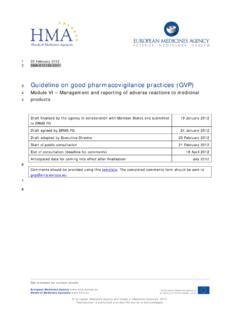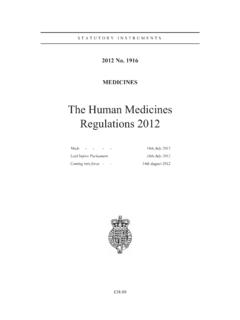Transcription of Guideline on good pharmacovigilance practices (GVP)
1 See websites for contact details European Medicines Agency Heads of Medicines Agencies The European Medicines Agency is an agency of the European Union European Medicines Agency and Heads of Medicines Agencies, 2019. Reproduction is authorised provided the source is acknowledged. EMA/653036/2019 DRAFT FOR PUBLIC CONSULTATION 1 4 December 2019 2 Guideline on good pharmacovigilance practices (GVP) 3 Product- or Population-Specific Considerations III: Pregnant and 4 breastfeeding women 5 Draft finalised by the Agency in collaboration with Member States 19 November 2019 Draft agreed by the EU Network pharmacovigilance Oversight Group (EU-POG) 29 November 2019 Draft adopted by Executive Director 4 December 2019 Release for public consultation 11 December 2019 End of consultation (deadline for comments) 28 February 2020 Anticipated date for coming into effect after finalisation Q4 2020/Q1 2021 6 Comments should be provided using this template.
2 The completed comments form should be sent to 7 Guideline on good pharmacovigilance practices (GVP) chapter EMA/653036/2019 DRAFT FOR PUBLIC CONSULTATION Page 2/27 Table of contents 8 3 9 pharmacovigilance aspects specific to the use of medicinal products in pregnant 10 or breastfeeding women .. 4 11 Availability and interpretation of data .. 4 12 Adverse events related to physiological changes of pregnancy .. 5 13 Susceptible periods and adverse pregnancy outcomes .. 5 14 Adverse events in the child following exposure through breastfeeding .. 6 15 Terminology .. 6 16 Structures and processes .. 8 17 Risk management plan .. 8 18 Management and reporting of adverse reactions.
3 9 19 Periodic safety update report .. 11 20 Post-authorisation safety studies .. 12 21 Pharmacokinetic studies on pregnancy-related physiological changes .. 13 22 Epidemiological studies .. 13 23 Pregnancy registries .. 14 24 Long-term pregnancy outcomes .. 15 25 Handling of bias and confounding .. 15 26 Clinical lactation studies .. 16 27 Signal management .. 17 28 Safety communication .. 17 29 Risk minimisation measures .. 18 30 Educational materials .. 19 31 Advice on effective contraception .. 20 32 Pregnancy prevention programme .. 20 33 Operation of the EU network .. 21 34 Submission of period safety update reports in the EU .. 21 35 Post-authorisation safety studies in the EU.
4 21 36 Appendix 1: .. Questionnaire to collect information on pregnancy 37 exposure .. 23 38 Appendix 2: Pregnancy testing and contraception for pregnancy 39 prevention during treatment with medicines of teratogenic potential .. 26 40 41 42 Guideline on good pharmacovigilance practices (GVP) chapter EMA/653036/2019 DRAFT FOR PUBLIC CONSULTATION Page 3/27 Introduction 43 The need for guidance on pharmacovigilance specifically for the use of medicinal products in pregnancy 44 is widely recognised. The use of medicinal products during breastfeeding is also an area in need of 45 further pharmacovigilance guidance. Pregnant and breastfeeding women are considered vulnerable, or 46 special populations, and in addition there are potential effects on the unborn child or breastfed infant.
5 47 This needs to be considered in the wider context of women of childbearing potential: pregnancy may 48 be unplanned, or treatment may be started at a young age or long before the woman is considering 49 pregnancy, so the effects of the medicine on pregnancy and the need to avoid pregnancy or for pre-50 conception counselling may have to be taken into account by the prescribing physician and the patient 51 in these contexts. 52 Except for situations where a medicine used during pregnancy specifically aims to benefit the (unborn) 53 child, risk-benefit considerations regarding the medicine use before or during pregnancy or 54 breastfeeding differ from other medicine use. This is because, in addition to the benefits and risks of 55 the medicine for the woman, the potential risks to the (unborn) child also need to be taken into 56 account.
6 In the case of pregnancy, the risks to be considered include not only those from exposure to 57 the medicine when used, but also the risks of untreated disease for the woman and the unborn child 58 when no medicine is used. In the case of breastfeeding, the benefits of breastfeeding need to be 59 weighed against the risks to the infant from medicine exposure through breast milk, and any effects of 60 medicine use on breast milk production also need to be considered. 61 Safety data obtained in the pre-authorisation phase are limited, due to the restrictions of clinical trials 62 in terms of size, time and duration of follow-up and the inclusion and exclusion criteria for selecting 63 participants.
7 Safety data for special populations are even more limited. Once a product is placed on the 64 market, if use in pregnancy and/or during breastfeeding is likely to occur, data collection to obtain a 65 better understanding of risks associated with such use and to identify and characterise risks is 66 important even where no safety concerns have arisen in the pre-authorisation phase. Whereas 67 historically, obtaining data from pregnant women on medicine use and outcomes during the post-68 authorisation phase has been challenging, it is becoming increasingly feasible to access data and 69 generate knowledge on safety in this population. 70 Increased and adequate data collection and data assessment in a timely manner will enable that 71 patients and prescribers have relevant information to make informed decisions about using medicines 72 during pregnancy or breastfeeding and that they are well-informed about uncertainties.
8 The guiding 73 principle is to keep adverse outcomes associated with medicine use during pregnancy and 74 breastfeeding to a minimum, without unnecessarily withholding useful treatment options from 75 pregnant and breastfeeding women. 76 This Product- and Population- Specific Considerations chapter of the good pharmacovigilance 77 practices (GVP) aims to provide guidance to marketing authorisation applicants/holders, competent 78 authorities of Member States and the Agency for facilitating appropriate pharmacovigilance for 79 medicinal products that may be used in pregnant or breastfeeding women. 80 In spontaneous reporting, the term adverse event is synonym to (suspected) adverse reaction and all 81 birth defects are (suspected) serious adverse reactions (see GVP Annex I).
9 In this GVP , the term 82 pregnancy outcome refers to the result of a pregnancy and hence may be a serious adverse reaction 83 (see ); this is different from general pharmacovigilance terminology in which the term 84 outcome refers to the result of an adverse reaction. 85 Taking into account that the general guidance on pharmacovigilance processes in the European Union 86 (EU) is provided in GVP Modules I to XVI, the guidance in this GVP aims at integrating 87 Guideline on good pharmacovigilance practices (GVP) chapter EMA/653036/2019 DRAFT FOR PUBLIC CONSULTATION Page 4/27 pharmacovigilance , including risk management, and considerations for pregnant and breastfeeding 88 women with the applicable structures and processes for pharmacovigilance overall.
10 GVP applies in 89 conjunction with the GVP Modules I to XVI and does not replace these GVP Modules or introduce 90 regulatory requirements in addition to those already covered in existing Modules. 91 In addition, the following guidelines should be consulted: 92 CHMP Guideline on Risk Assessment of Medicinal Products on Human Reproduction and Lactation: 93 from Data to Labelling (EMEA/CHMP/203927/2005)1; 94 CHMP Guideline on the Exposure to Medicinal Products During Pregnancy: Need for Post-95 authorisation Data (EMEA/CHMP/313666/2005)2; and 96 ICH-S5 (R3) Guideline on Detection of Toxicity to Reproduction for Human Pharmaceuticals3. 97 The effects of medicines on fertility and the use of medicines in neonates are out of scope of GVP ; 98 guidance on these areas is provided in GVP Module V on risk management planning and GVP chapter 99 on the paediatric population.












